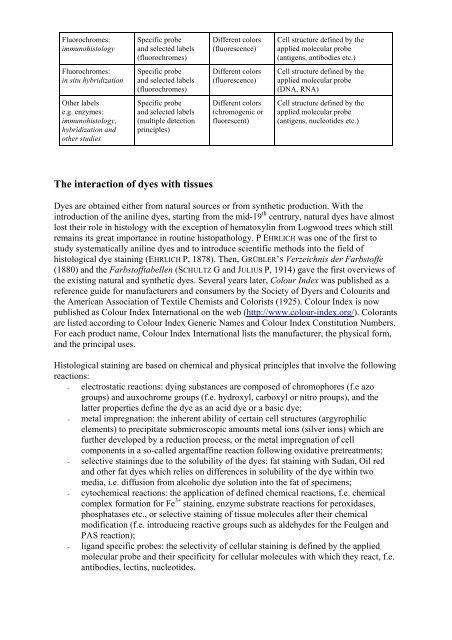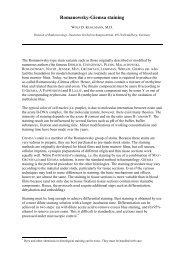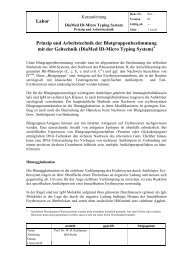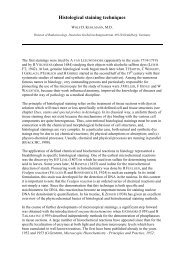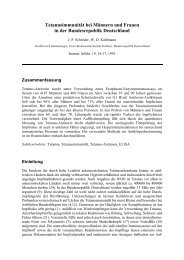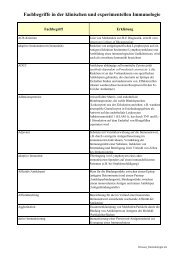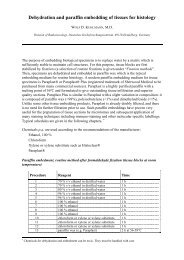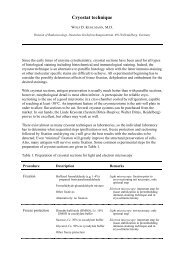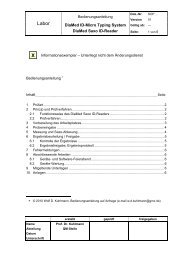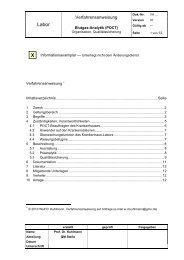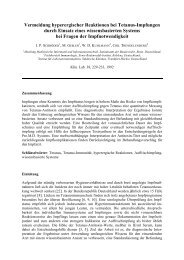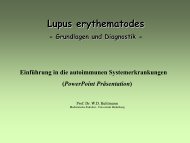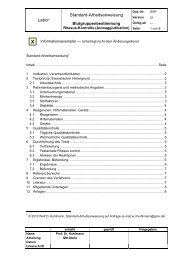Dyes, stains, and special probes in histology
Dyes, stains, and special probes in histology
Dyes, stains, and special probes in histology
You also want an ePaper? Increase the reach of your titles
YUMPU automatically turns print PDFs into web optimized ePapers that Google loves.
Fluorochromes:immuno<strong>histology</strong>Specific probe<strong>and</strong> selected labels(fluorochromes)Different colors(fluorescence)Cell structure def<strong>in</strong>ed by theapplied molecular probe(antigens, antibodies etc.)Fluorochromes:<strong>in</strong> situ hybridizationSpecific probe<strong>and</strong> selected labels(fluorochromes)Different colors(fluorescence)Cell structure def<strong>in</strong>ed by theapplied molecular probe(DNA, RNA)Other labelse.g. enzymes:immuno<strong>histology</strong>,hybridization <strong>and</strong>other studiesSpecific probe<strong>and</strong> selected labels(multiple detectionpr<strong>in</strong>ciples)Different colors(chromogenic orfluorescent)Cell structure def<strong>in</strong>ed by theapplied molecular probe(antigens, nucleotides etc.)The <strong>in</strong>teraction of dyes with tissues<strong>Dyes</strong> are obta<strong>in</strong>ed either from natural sources or from synthetic production. With the<strong>in</strong>troduction of the anil<strong>in</strong>e dyes, start<strong>in</strong>g from the mid-19 th centrury, natural dyes have almostlost their role <strong>in</strong> <strong>histology</strong> with the exception of hematoxyl<strong>in</strong> from Logwood trees which stillrema<strong>in</strong>s its great importance <strong>in</strong> rout<strong>in</strong>e histopathology. P EHRLICH was one of the first tostudy systematically anil<strong>in</strong>e dyes <strong>and</strong> to <strong>in</strong>troduce scientific methods <strong>in</strong>to the field ofhistological dye sta<strong>in</strong><strong>in</strong>g (EHRLICH P, 1878). Then, GRÜBLER’S Verzeichnis der Farbstoffe(1880) <strong>and</strong> the Farbstofftabellen (SCHULTZ G <strong>and</strong> JULIUS P, 1914) gave the first overviews ofthe exist<strong>in</strong>g natural <strong>and</strong> synthetic dyes. Several years later, Colour Index was published as areference guide for manufacturers <strong>and</strong> consumers by the Society of Dyers <strong>and</strong> Colourits <strong>and</strong>the American Association of Textile Chemists <strong>and</strong> Colorists (1925). Colour Index is nowpublished as Colour Index International on the web (http://www.colour-<strong>in</strong>dex.org/). Colorantsare listed accord<strong>in</strong>g to Colour Index Generic Names <strong>and</strong> Colour Index Constitution Numbers.For each product name, Colour Index International lists the manufacturer, the physical form,<strong>and</strong> the pr<strong>in</strong>cipal uses.Histological sta<strong>in</strong><strong>in</strong>g are based on chemical <strong>and</strong> physical pr<strong>in</strong>ciples that <strong>in</strong>volve the follow<strong>in</strong>greactions:- electrostatic reactions: dy<strong>in</strong>g substances are composed of chromophores (f.e azogroups) <strong>and</strong> auxochrome groups (f.e. hydroxyl, carboxyl or nitro proups), <strong>and</strong> thelatter properties def<strong>in</strong>e the dye as an acid dye or a basic dye;- metal impregnation: the <strong>in</strong>herent ability of certa<strong>in</strong> cell structures (argyrophilicelements) to precipitate submicroscopic amounts metal ions (silver ions) which arefurther developed by a reduction process, or the metal impregnation of cellcomponents <strong>in</strong> a so-called argentaff<strong>in</strong>e reaction follow<strong>in</strong>g oxidative pretreatments;- selective sta<strong>in</strong><strong>in</strong>gs due to the solubility of the dyes: fat sta<strong>in</strong><strong>in</strong>g with Sudan, Oil red<strong>and</strong> other fat dyes which relies on differences <strong>in</strong> solubility of the dye with<strong>in</strong> twomedia, i.e. diffusion from alcoholic dye solution <strong>in</strong>to the fat of specimens;- cytochemical reactions: the application of def<strong>in</strong>ed chemical reactions, f.e. chemicalcomplex formation for Fe 3+ sta<strong>in</strong><strong>in</strong>g, enzyme substrate reactions for peroxidases,phosphatases etc., or selective sta<strong>in</strong><strong>in</strong>g of tissue molecules after their chemicalmodification (f.e. <strong>in</strong>troduc<strong>in</strong>g reactive groups such as aldehydes for the Feulgen <strong>and</strong>PAS reaction);- lig<strong>and</strong> specific <strong>probes</strong>: the selectivity of cellular sta<strong>in</strong><strong>in</strong>g is def<strong>in</strong>ed by the appliedmolecular probe <strong>and</strong> their specificity for cellular molecules with which they react, f.e.antibodies, lect<strong>in</strong>s, nucleotides.


